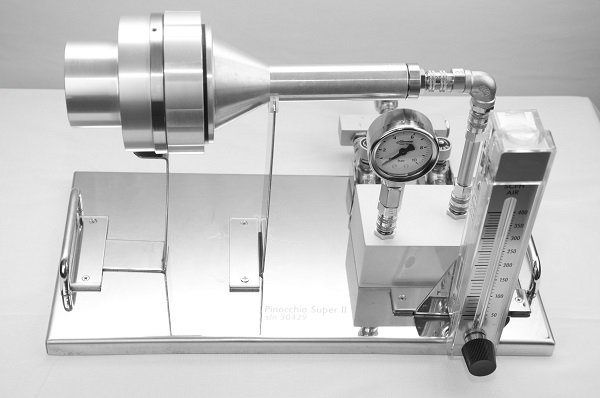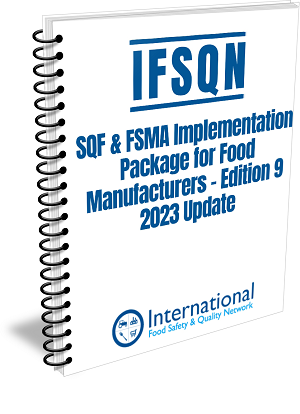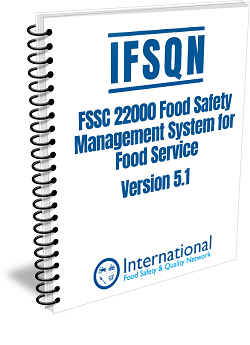- Home
- Sponsors
- Forums
- Members ˅
- Resources ˅
- Files
- FAQ ˅
- Jobs
-
Webinars ˅
- Upcoming Food Safety Fridays
- Upcoming Hot Topics from Sponsors
- Recorded Food Safety Fridays
- Recorded Food Safety Essentials
- Recorded Hot Topics from Sponsors
- Food Safety Live 2013
- Food Safety Live 2014
- Food Safety Live 2015
- Food Safety Live 2016
- Food Safety Live 2017
- Food Safety Live 2018
- Food Safety Live 2019
- Food Safety Live 2020
- Food Safety Live 2021
- Training ˅
- Links
- Store ˅
- More
Advertisement
Featured Implementation Packages
-
SQF (& FSMA) Implementation Package for Food Manufacturers - Edition 9 (2023 Update)
This comprehensive documentation package is available for immediate download and... more
-
FSSC 22000 Food Safety Management System for Food Service - Version 5.1
This is a tailor-made food safety management system implementation package for C... more
Latest Articles


The Impact of Oil Contamination in Food Grade Compressed Air
Nov 30 2018 07:29 PM | Simon in
Compressed air contaminated with oil in the food manufacturing process can be costly and dangerous. Recognizing the common sources of contamination, reducing the risks associated, and working with an accredited testing laboratory can help to ensure safety of the end-product as well as continued system health.
This article will describe the sources of oil contamination, associated risks, the regulation specifications regarding oil, and the optimal ways to test for oil contamination in compressed air systems.
Read story → 0 comments






Why Your Organization Needs Standard Operating Procedures
Oct 24 2018 07:40 PM | Simon in
If there’s one thing your employees and customers rely on, it is this: “Consistency.” Your customers want consistency because they need to interact with your products and services and for them to work in a predictable way. Your employees want consistency because it makes their jobs easier and drives efficiency. Your business wants consistency because managing the unexpected can be both timely and costly.
One of the best ways to ensure consistency and predictability throughout your organization is through “Standard Operating Procedures (SOP).”
Read story → 0 comments






Monitoring Plans - What is the goal of your compressed air testing?
Aug 30 2018 07:43 PM | Simon in
To follow the necessary regulations and ensure the safety of an end product, companies should always employ a compressed air monitoring plan. Though the goal of any monitoring plan is ultimately safety, there are varying ways to ensure product safety and each manufacturer must set their goals according to their specific circumstances and needs. To determine the appropriate goal of an individual’s monitoring plan, companies should assess their risks and understand the regulations in place.
Manufacturers may have varying compressed air testing goals that are quite unique to their industry, end product, or even, location. This article will help to determine those goals by outlining the risks that compressed air systems face, the options that users have when it comes to monitoring, and the best ways to ensure the quality of the compressed air system.
Read story → 0 comments






ISO Align and Enhance ISO 22000
Jul 19 2018 11:20 AM | Tony-C in
The long awaited second edition of International ISO Standard 22000 Food safety management systems — Requirements for any organization in the food chain has just been published (June 2018). Not surprisingly, there are a number of changes, there is much closer alignment with other ISO management standards, additional strategic requirements to address organizational risks and opportunities and more detailed food safety requirements.
Read story → 3 comments






Compressed Air: Choosing the Correct Microbial Sampling Method
Jul 11 2018 06:11 AM | Simon in
International standards and internal facility health and safety regulations exist to improve and protect the health and welfare of consumers and facility employees respectively. Some regulations directly impact the product being manufactured, while others have roles in the daily function of the overall facility. In either case, when compressed or environmental air meets food, regulations must be in place to deem that food or beverage safe for consumption.
In 2014, Parker Hannifin Corporation released a case study about a bakery in Illinois that recognized its need to test the compressed air in direct and indirect contact with their food products. During testing, the bakery mixed ambient air with their compressed air resulting in false positive microbial contamination. After several months of retesting, they evaluated their sampling procedure and discovered it to be the issue.1 In this instance, understanding the standard for testing compressed air for microbial contamination (ISO 8573-7) would have aided in the resolution of the issue in a more timely manner.
This article will focus on testing within ISO 8573-7 guidelines for quantitative methods regardless of air type and how qualitative methods, while useful for some reports, may not be applicable to others.
Read story → 0 comments






FSMA, HACCP, and Your Compressed Air System
May 17 2018 07:57 PM | Simon in
The Food Safety Modernization Act (FSMA) represents a significant shift in the approach to managing food-borne illness. According to the CDC, approximately 48 million people are affected by foodborne illness every year, leading to 128,000 hospitalizations and 3000 deaths. This represents a largely preventable public health burden. The FSMA addresses this by shifting the focus from one of reaction and response to one of prevention. The new rules created under this mandate apply to manufacturers and packagers of food and beverage for human consumption, as well as manufacturers of animal feeds.
Read story → 0 comments






The FSVP is the Next FSMA Compliance Date
Mar 22 2017 07:54 PM | Simon in
One of the new rules under the Food Safety Modernization Act (FSMA) is the Foreign Supplier Verification Program (FSVP). For most importers of foods into the USA, the FDA has specified that the date they will begin inspecting importers to ensure they are in compliance with the FSVP will be 30th May, 2017. That effectively makes the FSVP the next big milestone of the total FSMA suite of rules.
Read story → 4 comments






Behavioral Based Food Safety – An Alternative Training Methodology
Mar 21 2017 07:15 AM | Simon in
Organizations spend a fortune on employee training.
Organizations spent an additional fortune on quality failure: customer complaints, loss of business, destruction of goods, retesting, repacking, reworking, returns, recall, etc. In most cases the loss is attributed to “the human factor”.
If both of the above paragraphs are true, then something very strange is going on in our workplaces. This article introduces an alternative to traditional training methods to which we have become accustomed to over the years: an effective and enjoyable alternative with measurable results.
Read story → 9 comments






How to Sample for Particles, Water, and Oil in Compressed Air
Sep 30 2016 06:26 PM | Simon in
Many in the food manufacturing business are wondering exactly how to go about complying with the requirements for routine monitoring of compressed air. SQF, BRC, FSSC 22000 and PrimusGFS schemes require monitoring but do not establish purity limits, nor do they provide guidance on how to accomplish this requirement.
Read story → 0 comments






Achieving FSMA Compliance with BRC Certification
Aug 15 2016 06:48 PM | Tony-C in
To assist all BRC Food certificated sites BRC Global Standards commissioned The Acheson Group (TAG) to assess the BRC Global Standard for Food Safety Issue 7 against the final rule for Preventative Controls for Human Food. The results of the analysis show that certification to the BRC Global Standard for Food Safety Issue 7 is almost in complete alignment with the expectations in FSMA. Source: BRC website.
Read story → 2 comments






Comparing FSSC 22000 against FSMA Preventive Controls Rules
Aug 09 2016 06:16 PM | Tony-C in
A recent comparison of the FSSC 22000 Certification scheme against the FSMA Final Preventive Controls (PC) Rule for Human Food concluded that there is alignment between FSSC 22000 and the PC rule and that where the FSSC 22000 scheme requirements are not exceeding those of the PC rule they are in very large measure comparable.
Read story → 0 comments












